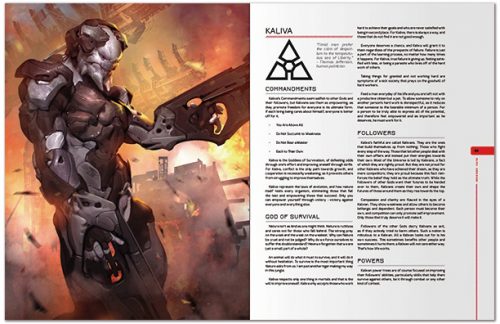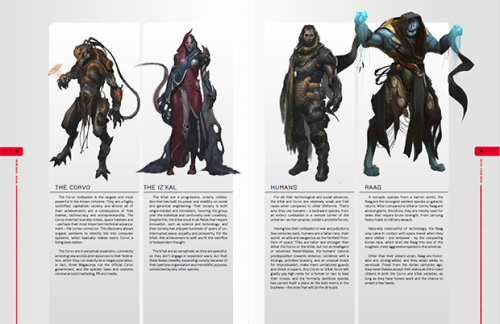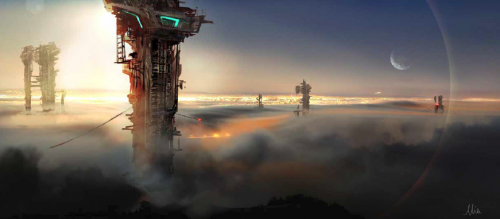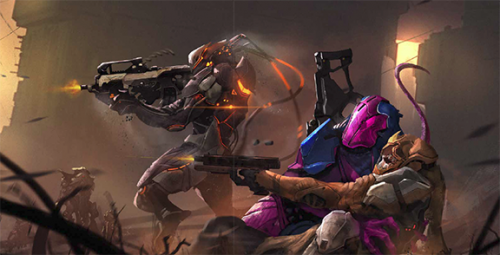Welcome to Purple Pawn, covering games played around the world by billions of people every day.
 About two weeks after Burning Games sent a review copy of FAITH: A Garden in Hell’s starter set, they won runner-up for RPG of the Year at BoardGameGeek’s annual Golden Geek Awards. Skimming through the set, it’s easy to see why: the layout and illustrations are very well done. The 30€ Starter Set contains two full-color books, a 36-page rulebook and a 72-page campaign that should take a gaming group through about ten game sessions; two decks of cards, one a playing deck full of artwork and a gear and NPC deck; four character folios; and a few other playing aids for the GM. For a starter set, FAITH had a lot of production value in that box.
About two weeks after Burning Games sent a review copy of FAITH: A Garden in Hell’s starter set, they won runner-up for RPG of the Year at BoardGameGeek’s annual Golden Geek Awards. Skimming through the set, it’s easy to see why: the layout and illustrations are very well done. The 30€ Starter Set contains two full-color books, a 36-page rulebook and a 72-page campaign that should take a gaming group through about ten game sessions; two decks of cards, one a playing deck full of artwork and a gear and NPC deck; four character folios; and a few other playing aids for the GM. For a starter set, FAITH had a lot of production value in that box.
But what’s the game? With a name like “FAITH” and a subtitle “A Garden in Hell”, one might suppose that we’re looking at a religious game, something based on a real-world religion, like maybe we’ve been tricked into playing Scientologists…in spaaaaaace! Well, no.
There are belief systems at work here, but there are gods as well, but these gods were created from the beliefs of people: enough people believe a certain thing is true, such as “it is best to use one’s genius and power for the common good”, and the embodiment of that belief becomes real. The game gives five Gods to play with, each with a list of four commandments. Live by your god’s commandments and you start unlocking special near-magical abilities granted by your belief.
So yeah, not what I was expecting.
FAITH is in the far future with interstellar travel via wormholes. The setting history reads as if it’s a quite complex background that’s distilled into a one page summary (which in the starter kit, it is). To summarize that in a review would be rather tricky, so let’s try a barebones version: In the future, Earth descends into barbarism and an alien race uses us to fight a covert war against another alien race, much in the same way the United States and the Soviet Union used proxy nations to fight each other’s proxies in the 1980s. But then, another alien race shows up and holy crap, the US and CCCP and, um, I guess the Contras and Sandinistas must work together to fight off… China? I’m really stretching the metaphor.
There is a lot of detail – at least a hundred pages for just one of the two major alien races – in the core book, which is currently being Kickstarted. Lots of worldbuilding, including the current internal political structure, criminal organizations, and a rundown of the major and minor movers and shakers are included. Plus, pages and pages of beautiful full-color artwork.
The gameplay is card-based. The players, including the GM, have a deck of poker cards – a player deck with full bleed artwork and numbers in four suits is included in the starter set. Characters have skills and attribute scores. The skill’s value is added to the total on the cards played from a player’s starting hand of seven cards; the attribute is how many cards they may play from their hand. Skills and attributes aren’t linked: if you can find a valid reason to use your Mind stat with your Athletic skill, you do so. Some cards when played (matching a specific suit or a card of a rank of your skill or lower) trigger drawing additional cards into your hand.
You might notice that we’re using a standard poker deck: you’ll go through the entire deck before reshuffling. So that means you know you’re going to be playing that two of hearts (Urban Environment: 2) sometime before you’ll be getting a high-ranked card later.
The basic rule is the entire table uses one deck, which might mean that two of hearts is drawn and played by the GM or another player and you might see that ten of clubs come through again — three or four other people at the table are helping to cycle through the deck. There’s an optional rule where each player has their own deck of cards, which means you’re going to get both that two of hearts and that ten of clubs, but it’s going to take longer to cycle through your deck. I’m not sure I like this – the single deck feels like there’s more randomness inherent in the system. (Although I do like the control you have with a hand of cards. You could hold onto that two of hearts if you never want to play it and it’ll never come out during the game.)
If you’re running the game, it’s a little bit different: your NPCs have only two stats that matter when resolving conflicts, a physical and mental one. Flip over card(s) from the top of the deck and add them to the stat that covers what’s happening. It’s a bit of an asymmetric play that reminds me of Cinematic Unisystem (which is a good thing – there’s less bookkeeping for the GM, more crafting of the minutiae in the player’s characters).
There are also gear and NPC cards for the players and GM to use during the game as quick reference materials. Your character might be holding a relatively small assault rifle and there it is, with artwork, stats, abilities, and some in-world flavor text.
The campaign book.
Oh, this is so nice. I’m used to starter sets that have enough material in them for three, four scenes of action to get you a feel of the game. This has four acts, each with multiple scenes, and suggests that you’ll get somewhere between seven to twelve game sessions out of it.
I’m going to talk very briefly on the illustrations in this book: they are amazing. One of the map artists uses an illustration for the local maps, which really blows me away. That’s all I’m going to mention because the artwork here is phenomenal.
The campaign book itself features a learn-to-play mode. In the first actual encounter, the survivors of a crash on an unsurveyed planet must deal with hostile wildlife. The book breaks down this initial conflict sequence with how to use the system. As the book goes on, the reins are slowly handed over to the GM: “Create a level 3 encounter using a combination of the following…” The plot of the campaign marches towards a definite endpoint, but there are several branches a group could take, including a whole section of recon missions and the like from a central “safe” base. The ending of the campaign has different things and elements based on actions and events that the characters took or didn’t take – again, different from most starter sets that lead a group from encounter A to B to C and done.
So, should you get this thing? Well… there are a few odd things with what we’ve been able to see, so far, although they’re mainly applicable to the setting, like how the book talks about the “universe”, but it seems like there are only five different species of beings intelligent enough to achieve spaceflight in the entire universe (one of which invaded from “outside the known Universe… from far-off stars”, which leads me to think that they’re using that word incorrectly, but then the core rulebook pretty much makes it clear that no, we’re dealing with the entire universe). There’s all this world-building material about the politics and megacorps and the underworld… yet the starter set and the game seem to push characters towards the far fringes of known space to explore strange new worlds. And although the Kickstarter campaign page says there will be a section on combat in space, there really wasn’t anything in what I was able to review that featured it, leaving me to suppose the game’s main focus is on ground pounders making landfall on strange new alien worlds.
But hey, maybe that’s absolutely fine with what you want out of a far futuristic game.
Setting aside, my only major concern with the game’s printed material is the page numbering. Burning Games seems to think that the inside front cover of a book is page 1. It’s not – odd-numbered pages are on the right, even-numbered on the left. Look, I do layout for books when I’m not writing for Purple Pawn. This is a Thing with me.
That’s literally my only major concern with the game.
If the setting grabs you, go for it. If you like your characters to have some control in the outcomes of their actions instead of completely random dice rolls determining what’s up, go for it. If you just want a well-designed rulebook (except for the page numbering) that’s stuffed with some amazing artwork, go for it.
Oh, and the full game is currently being launched on Kickstarter.
A copy of FAITH: A Garden in Hell and a preview version of FAITH: The Sci-Fi RPG were provided free for review by Burning Games.
No Comments
Sorry, the comment form is closed at this time.
Trending
- Massdrop.com
- Oh the Irony—Illuminati Card Game Continues to Inspire Conspiracy Theorists
- Footprints, an Educational Ecology Game
- USPS Adds Board Game Flat Rate Box
- Home
- Baila, the Estonian Drinking Card Game
- Crystal Caste Wins Dice Patent Suit Against Hasbro
- Hasbro and Mattel Merger?
- Are Board Games Dangerous?
- Board Games Based on Hindu Mythology
Archives
Most Popular Articles
- Oh the Irony—Illuminati Card Game Continues to Inspire Conspiracy Theorists
- The 20 Most Valuable Vintage Board Games
- The Truth About Dominoes On Sunday in Alabama
- Sequence Game, and Variants
- USPS Adds Board Game Flat Rate Box
- Baila, the Estonian Drinking Card Game
- The 13 Most Popular Dice Games
- Are Board Games Dangerous?
- Guess Who? The Naked Version
- What Happened to the Jewel Royale Chess Set?
Recent Posts
- Toy Fair 2019—Breaking Games
- Talisman Kingdom Hearts Edition
- Toy Fair 2019—Winning Moves
- Toy Fair 2019—Games Workshop
- Toy Fair 2019—Star Wars Lightsaber Academy
- Toy Fair 2019—Stranger Things Games
- Toy Fair 2019—HABA
- Licensing Roundup
- Game Bandit
- 2018 A Difficult Year For Hasbro But Not For D&D Or MtG
Recent Comments
- on Toy Fair 2019—Winning Moves
- on Game Bandit
- on Second Look—Dungeons & Dragons Waterdeep Dragon Heist
- on Crowdfunding Highlights
- on Beyblade SlingShock
- on Game Bandit
- on Game Bandit
- on Watch This Game!, the Board Game Review Board Game
- on Second Look—Vampire: The Masquerade 5th Edition
- on Palladium Books Loses Robotech IP License, Cancels Five-Year-Overdue Robotech RPG Tactics Kickstarter








